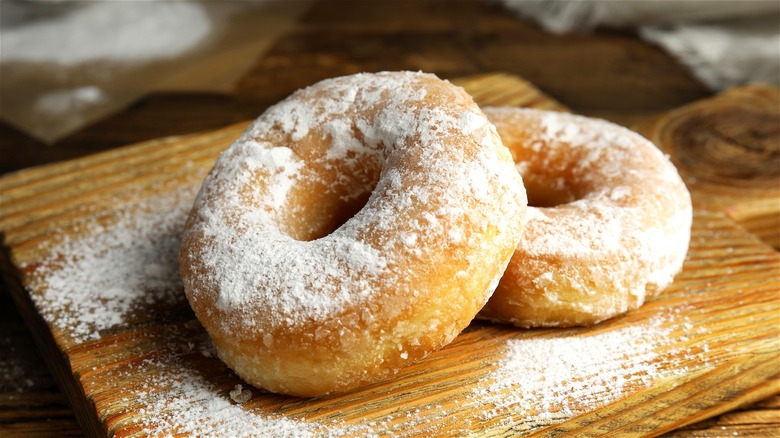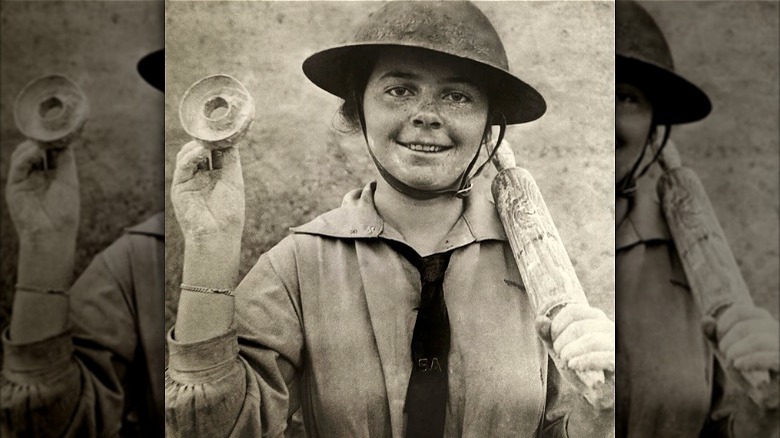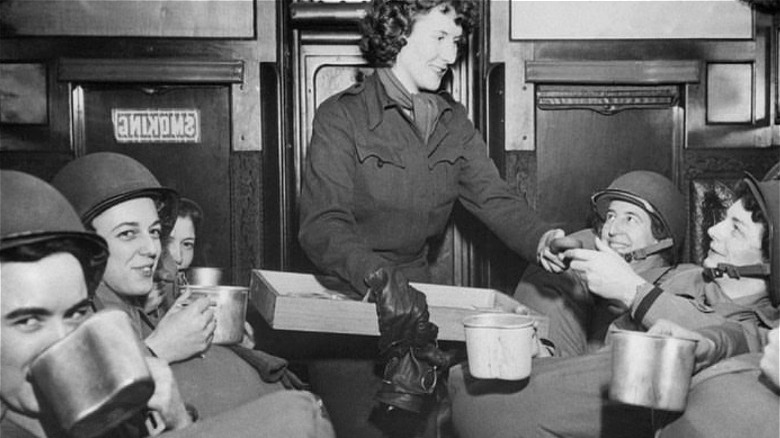The Key Role Doughnuts Played In World War I
In all their glazed and chewy deep-fried glory, doughnuts have become one of those indulgent foods most Americans willingly enjoy. The South Florida Reporter claims 10 billion doughnuts are made in the U.S. each year. Better yet, according to Statista, 201.02 million Americans happily consumed their fair share of doughnuts in 2020. While it's safe to say the average foodie wouldn't pass up a free doughnut or two, where did this sweet, round delicacy originate?
The New York Times states that this fried delicacy has been around for thousands of years: A similar concoction had been prepared and enjoyed by early Indigenous communities. However, Smithsonian indicates the growth of the popular doughnut or "donut" we know and love today can be linked to Dutch immigrants and their culturally rich recipe for olykoeks, which are sweetly fried dough-like treats that mimic the modern-day donut without that signature hollowed-out circular shape (per Logically).
The National Day Calendar claims that the ever-present hole became a doughnut mainstay in 1847, when one sailor attempted to steer a ship at sea while simultaneously enjoying his version of the confection. While you could say the rest is history that doesn't tell the "hole" story. Before you continue enjoying the best doughnut chains in America, let's delve into how the doughnut became an emblem of American culture during the First World War.
Doughnuts brought soldiers comfort amidst a time of uncertainty
While World War I officially began in 1914, doughnuts arrived in France to help alleviate the fear and stress prevalent among young U.S. troops a few years later. According to ABC News, American Salvation Army officers Helen Purviance and Margaret Sheldon were sent to France in 1917 to bring positivity and comfort to frontline-serving American soldiers. To relieve these young men of their ill feelings after being forced into war overseas, Purviance decided to look for eggs so the two Salvation Army officers could make these young heroes a baked treat that reminded them of home. Why had doughnuts become the treat of choice you wonder?
Mental Floss notes that doughnuts often posed as an adaptable treat, with ingredients swapped here and there as necessary. Purviance and Sheldon found doughnuts to be somewhat easy to prepare on the front lines with the help of empty baking powder canisters and shell casings. Once The Salvation Army streamlined its process, numerous female morale-building officers were able to make up to 5,000 doughnuts per day and became nicknamed "Doughnut Lassies."
Among the delicious homemade doughnut recipes you could try, you may want to try The Salvation Army's longtime recipe in celebration of National Doughnut Day, which was commemorated in 1938. Interestingly, however, doughnuts continued to relieve soldiers in their subsequent war efforts for many years after World War I.
The iconic link between doughnuts and democracy
While testing out the most iconic foods from every state might be a fun experience, there's nothing wrong with sticking with a national mainstay. After all, doughnuts are entrenched in American history. Beyond their growth in popularity during World War I, doughnuts continued to serve as a symbol of relief for American soldiers after 1918.
In the midst of World War II, Delaware.gov claims club mobiles were sent overseas to provide aid and comfort to American soldiers through the American Red Cross. Not only did these small bus-like mobiles contain some of life's simple pleasures like newspapers and cozy sitting rooms, but they always came with hot coffee and fresh doughnuts made by the American Red Cross female volunteers nicked "donut dollies."
According to the Military Women's Memorial, these "donut dollies" remained a staple in wartime culture through the Vietnam War. These women and their efforts underwent a title change for their efforts to "Supplemental Recreational Activities Overseas" offering comfort and endless doughnuts to American soldiers in need of relief and assurance during times of strife. While Smithsonian outlines how popular doughnut chains and shops began opening at large in America in the 1950s, doughnuts have signified comfort and freedom to many American soldiers for countless years before they became an everyday treat for the average American consumer.


